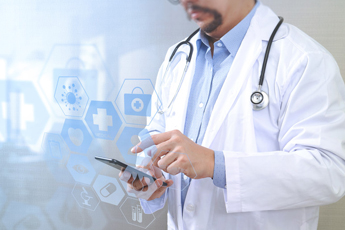 The data in electronic health records (EHRs), which physicians, scribes, and medical transcription companies provide, include all the important aspects relevant to a person’s care under a particular provider such as demographics, progress notes, problems, medications, vital signs, past medical history, immunizations, laboratory data and radiology reports. A health informatics team at UC San Francisco (UCSF) recently used this data to identify the source of Clostridium difficile or C. diff., a common hospital-acquired infection. The researchers tracked the EHRs of more than 85,000 patients between 2013 and 2016 to trace the movements of the C. diff. bacterium. The results of the study were published in JAMA Internal Medicine in October 2017.
The data in electronic health records (EHRs), which physicians, scribes, and medical transcription companies provide, include all the important aspects relevant to a person’s care under a particular provider such as demographics, progress notes, problems, medications, vital signs, past medical history, immunizations, laboratory data and radiology reports. A health informatics team at UC San Francisco (UCSF) recently used this data to identify the source of Clostridium difficile or C. diff., a common hospital-acquired infection. The researchers tracked the EHRs of more than 85,000 patients between 2013 and 2016 to trace the movements of the C. diff. bacterium. The results of the study were published in JAMA Internal Medicine in October 2017.
The Centers for Disease Control and Prevention (CDC) currently identifies C. difficile as “the most common microbial cause of healthcare-associated infections in U.S. hospitals and costs up to $4.8 billion each year.” In 2013, the CDC classified the threat level of C. difficile as urgent, putting the bacterium among the top 3 of 18 drug-resistant microbes, at a much higher level than tuberculosis and methicillin-resistant staphylococcus aureus (MRSA). This bacterium can cause severe diarrhea, colitis, toxic megacolon, organ failure, and death.According to a recent report in Medical News Today, those at the highest risk of C. difficile infection are those over 65s, especially people who are hospitalized and taking antibiotics.
Infections are considered hospital-acquired if they first appear 48 hours or more after hospital admission or within 30 days after discharge. Premature babies, young children, the elderly, the severely ill, and those with chronic conditions or undergoing treatments that undermine the immune system are at higher risk of hospital acquired infections. While not all hospital-acquired infections can be prevented, the vast majority of them can.
UCSF is committed to reducing rates of hospital-acquired infections. However, the source of C. diff is particularly challenging to track and identify due to the complex interactions and location changes that take place in hospitals. Hospitalized patients visit many procedural and diagnostic common areas, thereby increasing the chances of contact with contaminated surfaces. However, when the causes of disease transmission are evaluated, these potential exposures are usually not captured, the researchers noted.
EHR data includes time and location stamps that are entered whenever patients undergo radiological scans, operations and other procedures, or are moved to different parts of the hospital. The UCSF Health Informatics team used these time and location stamps in EHRs to track the movements of the C.diff bacterium. Patients who passed through a space while it was potentially contaminated were considered “exposed” to C. diff. They examined the experiences of the patients who visited the same locations within 24 hours of an infected patient, the period in which that location that the study considered as “potentially contaminated”. These patients were considered “exposed” to C. diff. The team mapped 435,000 patient location changes throughout the UCSF Medical Center at Parnassus over the three-year study period.
The team found that patients who were exposed to certain CT scanner in the Emergency Department (ED) were at a high risk of exposure-related infections:
- Patients who entered that scanner within 24 hours after C. diff-positive patients were more than twice as likely to become infected with the bacterium themselves.
- 4 percent of the patients who were considered exposed in the scanner developed C. diff within two months.
- The overall rate of infection for patients who passed through the scanner was 1.6 percent.
According to the chief quality officer for UCSF Health and professor of medicine, at UCS, the study highlights the significance of leveraging EHRs to tackle a common health care problem. The research is unique in that it looked into not just disease transmission risks in the patient’s room or on the same hospital floor, but every location in the hospital that the patient goes. As the result of the findings, the hospital quickly took measures to standardize the cleaning practices for that scanner to match those used in other radiology suites. No other sites at the hospital raised concerns regarding C. diff transmission in the three years under review.
Studies such as these underline the importance of ensuring the reliability and integrity of EHR data. Medical practices of any size can use EHR data analytics:
- To gain timely and accurate information needed to generate customized reports
- To discover patterns and improve the level of healthcare they provide
- Make better business decisions
- Ensure compliance with industry regulations
To harness the power of big data and data analytics, providers need to ensure the accuracy and the completeness of the data in the patient’s health record. Medical transcription outsourcing is a reliable strategy when it comes to managing EHR data entry with timely and accurate capture of patient information which can lead to better decisions on patient care as well as financial aspects.


